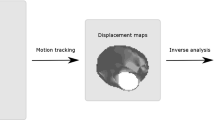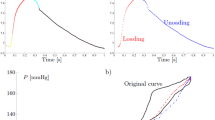Abstract
The mechanical properties of human biological tissue vary greatly. The determination of arterial material properties should be based on experimental data, i.e. diameter, length, intramural pressure, axial force and stress-free geometry. Currently, clinical data provide only non-invasively measured pressure-diameter data for superficial arteries (e.g. common carotid and femoral artery). The lack of information forces us to take into account certain assumptions regarding the in situ configuration to estimate material properties in vivo. This paper proposes a new, non-invasive, energy-based approach for arterial material property estimation. This approach is compared with an approach proposed in the literature. For this purpose, a simplified finite element model of an artery was used as a mock experimental situation. This method enables exact knowledge of the actual material properties, thereby allowing a quantitative evaluation of material property estimation approaches. The results show that imposing conditions on strain energy can provide a good estimation of the material properties from the non-invasively measured pressure and diameter data.








Similar content being viewed by others
Abbreviations
- \( {\Psi } \) :
-
Strain energy density function
- \( {\Psi _\mathrm{mat}}\) :
-
Isotropic contribution of the extracellular matrix material to the strain energy density function
- \( {\Psi _\mathrm{col}} \) :
-
Anisotropic contribution of the collagen fibre families to the strain energy density function
- \( I_1 \) :
-
First invariant of the right Cauchy–Green strain tensor
- \( I_4 \) :
-
Invariant related to the orientation of the collagen fibre families
- \( \lambda _i \) :
-
\( i = r,\theta ,z \), three principal stretch ratios in the radial, circumferential and the axial directions of the artery, respectively
- \( \mu \) :
-
Stress-like parameter representing the stiffness of the matrix material
- \( k_1 \) :
-
Stress-like parameter representing the stiffness of the collagen fibres
- \( k_2 \) :
-
Dimensionless parameter of the collagen fibres
- \( \alpha \) :
-
Angle between the mean collagen fibre direction and the circumferential direction of the artery
- \( \kappa \) :
-
Parameter related to the dispersion of the collagen fibres
- \( L \) :
-
Initial axial sample length
- \( l \) :
-
Deformed axial sample length
- \( R_\mathrm{o} \) :
-
Outer radius in the stress-free configuration
- \( R_\mathrm{i} \) :
-
Inner radius in the stress-free configuration
- \( \rho _\mathrm{o} \) :
-
Outer radius in the unloaded configuration
- \( \rho _\mathrm{i} \) :
-
Inner radius in the unloaded configuration
- \( r_\mathrm{o} \) :
-
Outer radius in the loaded configuration
- \( r_\mathrm{i} \) :
-
Inner radius in the loaded configuration
- \( R \) :
-
Initial radius at a certain position
- \( r \) :
-
Deformed radius at a certain position
- \( {\Theta _0} \) :
-
Opening angle in the stress-free configuration
- \( \varvec{F_1} \) :
-
Deformation gradient relating the stress-free and the loaded configuration
- \( \varvec{F_2} \) :
-
Deformation gradient relating the unloaded and the loaded configuration
- \( {\mathcal {R}}_0 \) :
-
Stress-free configuration
- \( {\mathcal {R}}_1 \) :
-
Unloaded configuration
- \( {\mathcal {R}}_2 \) :
-
Loaded configuration
- \( R,\theta ,z \) :
-
Radial, circumferential and axial cylindrical coordinates in the stress-free configuration
- \( \rho ,\phi ,\xi \) :
-
Radial, circumferential and axial cylindrical coordinates in the unloaded configuration
- \( r,\theta ,z \) :
-
Radial, circumferential and axial cylindrical coordinates in the stress-free configuration
- \( \varLambda \) :
-
Axial stretch ratio between the stress-free and the unloaded configuration
- \( \lambda \) :
-
Axial stretch ratio between the unloaded and the loaded configuration
- \( \lambda _z \) :
-
Total stretch in the axial direction
- \( H \) :
-
Wall thickness in the stress-free and unloaded configuration
- \( h \) :
-
Wall thickness in the loaded configuration
- \( j \) :
-
Index going from 1 to \(n\), \(n\) being the total number of data points considered
- \( k \) :
-
Index representing different points throughout the arterial wall, going from 1 at the inner wall to \(m\) at the outer wall
- \( \varvec{F}^\mathrm{FEM} \) :
-
Reduced axial forces extracted from the simulation
- \( \varvec{r_\mathrm{o}} \) :
-
Outer radii extracted from the simulation
- \( \varvec{P}^\mathrm{FEM} \) :
-
Pressures extracted from the simulation
- \(\textit{pars}\) :
-
Vector of fitted parameters
- \( w_\mathrm{p} \) :
-
Weighting factor for the pressure in the objective function
- \( w_\mathrm{f} \) :
-
Weighting factor for the force in the objective function
- \( \varvec{P}^\mathrm{mod} \) :
-
Intraluminal pressures predicted by the function \({\Psi }\)
- \( \varvec{F}^\mathrm{mod} \) :
-
Reduced axial forces predicted by the function \({\Psi }\)
- \( \varvec{A}^\mathrm{mod} \) :
-
Cross-sectional area predicted by the function \({\Psi }\)
- \( \lambda _{\mathrm{o}} \) :
-
Circumferential axial stretch at the outer wall
- \( \lambda _{\mathrm{i}} \) :
-
Circumferential axial stretch at the inner wall
- \( \varvec{\sigma }_{\theta \theta }^\mathrm{mod} \) :
-
Circumferential stresses predicted by the function \({\Psi }\)
- \( \varvec{\sigma }_{\theta \theta } \) :
-
Circumferential stress calculated by enforcing the equilibrium
- \( \varvec{\sigma _{zz}}^\mathrm{mod} \) :
-
Axial stresses predicted by the function \({\Psi }\)
- \( \varvec{\sigma }_{zz} \) :
-
Axial stresses calculated by enforcing the equilibrium
- \( F^\mathrm{est} \) :
-
Estimated reduced axial force
- \( \bar{P} \) :
-
An arbitrary pressure, e.g. 100 mmHg
- \( \bar{r}_{\mathrm{i}} \) :
-
Inner radius related to the pressure \(\bar{P}\)
- \( \bar{h}_{\mathrm{i}} \) :
-
Wall thickness related to the pressure \(\bar{P}\)
- \( \gamma \) :
-
Ratio of the axial to the circumferential stresses at the pressure \(\bar{P}\)
- \( w_{{\Psi 1}} \) :
-
Weighting factor for the strain energy density across the wall thickness
- \( w_{{\Psi 2}} \) :
-
Weighting factor for the strain energy density at diastole
- \( F^\mathrm{average} \) :
-
Average of \(\varvec{F}^\mathrm{mod}\)
- \( \varvec{{\Psi }}^{\mathrm{dias, mod}} \) :
-
Strain energy density at diastole
- \(\varvec{{\Psi }}^\mathrm{average} \) :
-
Average of \({\varvec{{\Psi }}}^\mathrm{dias,mod}\)
- \( \varvec{{\Psi }}^{\mathrm{dias, mod}}_{\mathrm{coll}} \) :
-
Collagen strain energy density at diastole
- \( \varvec{{\Psi }}^{\mathrm{dias,mod}}_{\mathrm{mat}}\) :
-
Matrix strain energy density at diastole
References
Böl M, Abilez OJ, Assar AN, Zarins CK, Kuhl E (2012) In vitro/in silico characterization of active and passive stresses in cardiac muscle. Int J Multiscale Comput Eng 10(2):171–188
Cardamone L, Valentín A, Eberth JF, Humphrey JD (2009) Origin of axial prestretch and residual stress in arteries. Biomech Model Mechanobiol 8(6):431–446
Chuong CJ, Fung YC (1986) Residual stress in arteries. In: Schmid-Schönbein GW, Woo L-Y, Zweifach BW (eds) Frontiers in biomechanics, part II. Springer, New York, pp 117–129
Famaey N, Sommer G, Holzapfel GA (2012) Arterial clamping: finite element simulation and in vivo validation. J Mech Behav Biomed Mater 12:107–118
Famaey N, Vander Sloten J (2013a) A three-constituent damage model for arterial clamping in computer-assisted surgery. Biomech Model Mechanobiol 12(1):123–136
Famaey N, Štrbac V, Vander Sloten J (2013b) Intraoperative damage monitoring of endoclamp balloon expansion using real-time finite element modeling. Springer, Berlin
Fung YC, Fronek K, Patitucci P (1979) Pseudoelasticity of arteries and the choice of its mathematical expression. Am J Physiol 237(5):H620–H631
Gasser TC, Ogden RW, Holzapfel GA (2006) Hyperelastic modelling of arterial layers with distributed collagen fibre orientations. J R Soc Interface 3(6):15–35
Haskett D, Johnson G, Zhou A, Utzinger U (2010) Microstructural and biomechanical alterations of the human aorta as a function of age and location. Biomech Model Mechanobiol 9(6):725–736
Holzapfel GA, Gasser TC, Ogden RW (2000) A new constitutive framework for arterial wall mechanics and a comparative study of material models. J Elast Phys Sci Solids 61(1–3):1–48
Humphrey JD (2002) Cardiovascular solid mechanics: cells, tissues and organs. Springer, Berlin
Masson I, Boutouyrie P, Laurent S, Humphrey JD, Zidi M (2008) Characterization of arterial wall mechanical behavior and stresses from human clinical data. J Biomech 41(12):2618–2627
Murtada S-I, Kroon M, Holzapfel GA (2010) A calcium-driven mechanochemical model for prediction of force generation in smooth muscle. Biomech Model Mechanobiol 9(6):749–762
Nichols M, Townsend N, Scarborough P, Rayner M (2013) European cardiovascular disease statistics 4th edition 2012: euroheart ii. Eur Heart J 34(39):3007
Ogden RW (2009) Anisotropy and nonlinear elasticity in arterial wall mechanics. In: Holzapfel GA, Ogden RW (eds) Biomechanical modelling at the molecular, cellular and tissue levels. Springer, New York, pp 179–258, CISM Courses and Lectures no. 508
Rachev A, Greenwald SE (2003) Residual strains in conduit arteries. J Biomech 36(5):661–670
Rietzschel E-R, De Buyzere ML, Bekaert S, Segers P, De Bacquer D, Cooman L, Van Damme P, Cassiman P, Langlois M, van Oostveldt P, Verdonck P, De Backer G, Gillebert TC, A. I (2007) Rationale, design, methods and baseline characteristics of the asklepios study. Eur J Cardiovasc Prev Rehabil 14(2):179–191
Roach MR, Burton AC (1957) The reason for the shape of the distensibility curves of arteries. Can J Biochem Physiol 35(8):681–690
Schulze-Bauer CAJ, Holzapfel GA (2003) Determination of constitutive equations for human arteries from clinical data. J Biomech 36(2):165–169
Stålhand J (2009) Determination of human arterial wall parameters from clinical data. Biomech Model Mechanobiol 8(2):141–148
Stålhand J, Klarbring A (2005) Aorta in vivo parameter identification using an axial force constraint. Biomech Model Mechanobiol 3(4):191–199
van der Horst A, van den Broek CN, van de Vosse FN, Rutten MCM (2012) The fiber orientation in the coronary arterial wall at physiological loading evaluated with a two-fiber constitutive model. Biomech Model Mechanobiol 11(3–4):533–542
Vito RP, Dixon SA (2003) Blood vessel constitutive models-1995–2002. Annu Rev Biomed Eng 5:413–439
Weizsäcker HW, Lambert H, Pascale K (1983) Analysis of the passive mechanical properties of rat carotid arteries. J Biomech 16(9):703–715
Wittek A, Karatolios K, Bihari P, Schmitz-Rixen T, Moosdorf R, Vogt S, Blase C (2013) In vivo determination of elastic properties of the human aorta based on 4d ultrasound data. J Mech Behav Biomed Mater 27:167–183
Wolinsky H, Glagov S (1964) Structural basis for the static mechanical properties of the aortic media. Circ Res 14:400–413
Acknowledgments
This research was supported by Research Foundation Flanders (FWO Vlaanderen).
Author information
Authors and Affiliations
Corresponding author
Rights and permissions
About this article
Cite this article
Smoljkić, M., Vander Sloten, J., Segers, P. et al. Non-invasive, energy-based assessment of patient-specific material properties of arterial tissue. Biomech Model Mechanobiol 14, 1045–1056 (2015). https://doi.org/10.1007/s10237-015-0653-5
Received:
Accepted:
Published:
Issue Date:
DOI: https://doi.org/10.1007/s10237-015-0653-5




